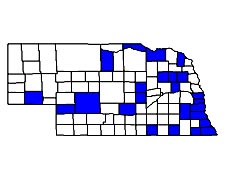
| Cicindela sexguttata Fabricius |
| Adult Length: 11.5 to 14.5 mm |
| Appearance: The brilliant green color of this tiger beetle is likely a familiar sight to many who have walked sunlit woodland trails in the eastern states. Though this species is commonly called the six-spotted tiger beetle, it may lack dots entirely or have as many as ten whitish spots on the elytra. Dots are usually small, but on rare occasions, the two dots in the middle of each elytron may be nearly fused. In contrast to the appearance of this species in much of its range, most Nebraska specimens are immaculate or have only two tiny whitish dots. The ground color is brilliant green in most cases, but in Nebraska it may often be blue or violet. The purple-blue color appears to be somewhat localized geographically, with some populations dominated by green individuals and others by purple-blue ones. In the Great Lakes Region, blue and violet individuals do not occur, but in the Deep South and the eastern Great Plains, they are relatively common. Because of this, names such as kansansus and violacea have been applied to populations in the plains and the south respectively. Because this trait is seldom consistent and sometimes highly localized, the use of these names at the subspecies level is not valid. Specimens in collections have a tendency to become deep blue with age, and this may be related to dryness, sunlight exposure, or heat. Any of these may shrink the thickness of the cuticle, resulting in shorter wavelength reflective colors. In light of this it is interesting to note that natural blue and violet individuals occur readily in areas of the highest average summer temperatures within the range of this species. |
| Similar Species: This species could be confused with C. denverensis or rarely with blue or green individuals of C. punctulata. In C. denverensis the green or blue color is less brilliant and the front of the head has a patch of setae (hairs), which are lacking in C. sexguttata. Blue and green specimens of C. punctulata will have a row of tiny pits evident near the elytral suture. |
| Biology: This species occurs in sunny areas in moist woodlands. It can occur on a variety of soil types, but is more numerous on sandy and loamy soils than on clay. Adults can be noted foraging on dead logs, forest trails, and in sunlit areas of exposed soil within woodlands. Adults may also venture some distance from the forest. Adults of this species are less active foragers than many other species. They will often set up position on dead leaves, a dead log, or a rock, and ambush any arthropod that wanders close. A large rock may be shared by several adults, each spaced about twenty centimeters or more apart. Despite their patient hunting methods, they are fast runners. They are moderately skittish, flying off in a zigzag flight when alarmed. Adults also have a unique habit of often flying into and alighting on foliage briefly when alarmed, only to return to an open area within a minute or two. Its two sister species, C. patruela and C. denikei, will also fly into vegetation, and C. patruela will hide among grasses if repeatedly harassed. |
| Adult Life History: Adults emerge from the pupae in August and September, but mostly remain underground until spring. Occasionally, one or a few fall individuals may be found from time to time from late August to November. After overwintering, adults begin to appear from late April into May, and peak numbers are reached in June. Numbers decline rapidly in July, and only a small handful survive into August. There may be some limited fall activity as adults have turned up in pitfall traps in September. |
| Larval Life History: Larvae occur in vertical burrows in bare and partially vegetated areas with at least some sunlight exposure. The larval stage lasts two years. Eggs are laid in May and June, and larvae reach the third instar by fall before overwintering. Pupation occurs during the following summer. |
| Biogeography: This species is apparently confined mostly to the eastern quarter of Nebraska. It appears to occur a little further west in the northern part of the state, particularly near the Missouri River. It is apparently lacking in the Platte River Valley in both Buffalo and Hall Counties, but has been encountered elsewhere in Buffalo County. It should be watched for in the Pine Ridge, as there are records from the Black Hills of South Dakota and Devil’s Tower in Wyoming. Though it is consistent in woodlands in easternmost Nebraska, its distribution appears spotty elsewhere. It certainly appears to be associated with rivers and streams with fairly consistent flow as it was found at several sites along the Loup and Elkhorn Rivers in 2004. Such an association with waterways and riverine forests is likely the result of moisture limitations in the Great Plains. Though it is a common species across the eastern United States, southeastern Ontario and southernmost Quebec, its distribution in the Great Plains become spotty, and the western limits of its range are poorly known. |








